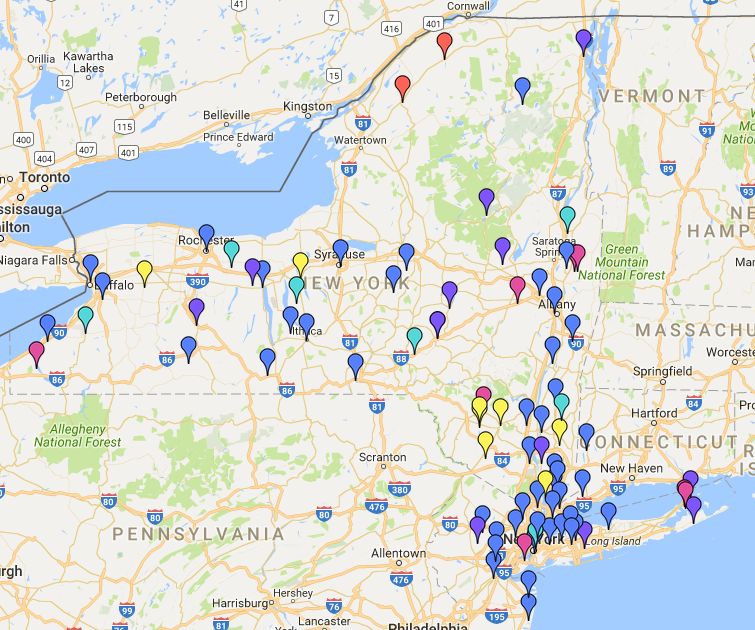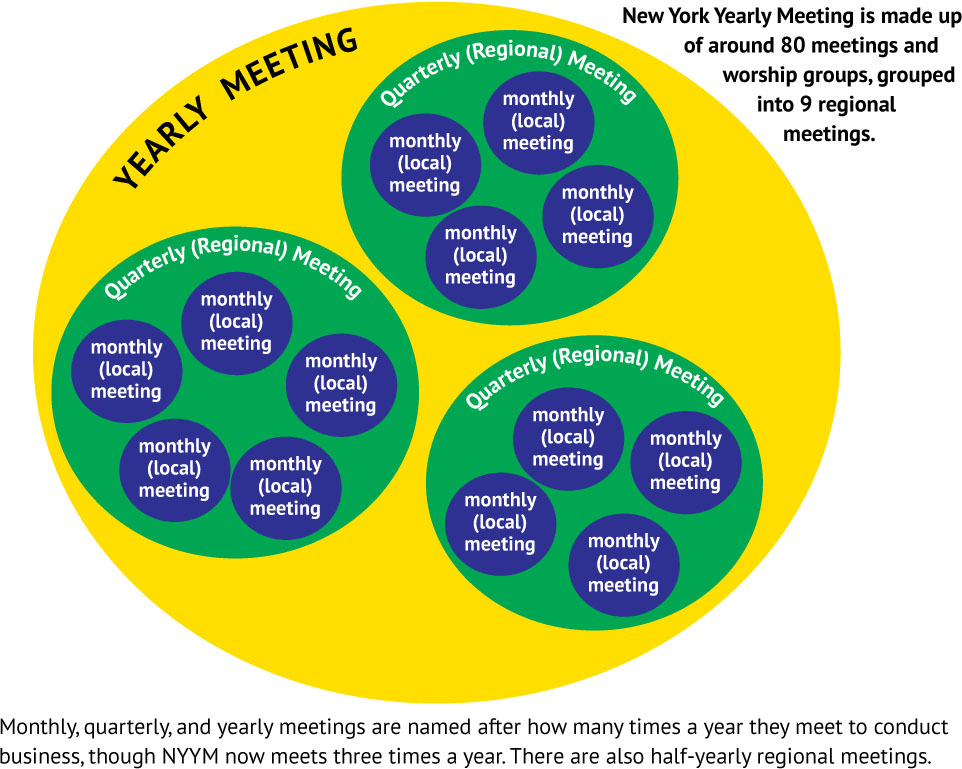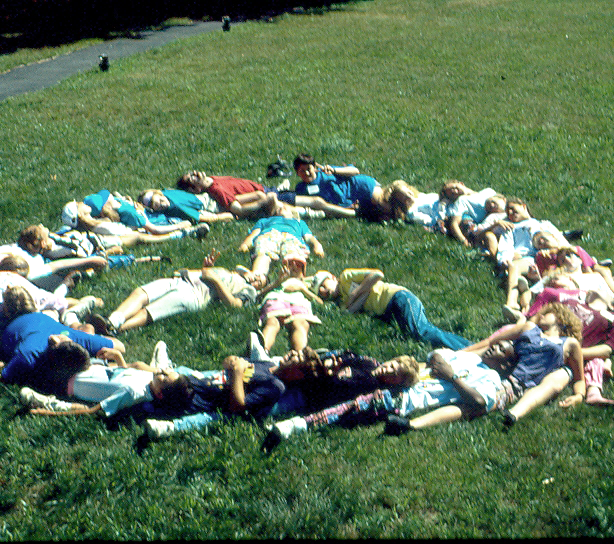Staff Plenary Presentation, Summer Sessions 2016
Nurturing the Blessed Community Across the Spectrum of Age
Plenary Session with NYYM Staff — Summer Sessions 2016
Wednesday, July 27, 2016
Christopher Sammond, General Secretary
I was asked to share three stories which help illustrate how I contribute to our overall staff effort in nurturing Friends across the spectrum of age in our yearly meeting.
One of the best parts of my work is visiting monthly meetings. My ‘meeting visitation odometer’ passed 250 visits some time ago, and in visiting so many meetings, multiple times over the years, I have the privilege of hearing about the spiritual journeys of individuals over time. One Friend, an elderly gentleman, who had spent his life in service, giving whole-heartedly to others for most of his life, shared his sorrow with me over how his progressive disease was making that no longer possible. This was a major life change for him; he had lost much of his sense of meaning and purpose.
I shared with him my experience of how in every community there is a cycle of giving and receiving. For that cycle to be robust and alive, someone needs to be willing to receive. If there is no place for others’ giving to go, the cycle of giving and receiving which is an incredibly powerful engine for community building never gets going, much to the community’s detriment. I offered the possibility that perhaps at this stage in his life, his calling was to receive, rather than to give. And that in receiving, he was giving his community a great gift.
I talked to him some months later, and he was filled with joy and enthusiasm, having embraced a new meaning and purpose, and already seeing the potential for this gift of his receiving for the wider community.
The next story I would tell happened at the retreat for the Advancement Committee, the Spiritual Nurture Working Group, the Young Adult Concerns Committee, the Intervisitation Program, and perhaps some others. After one plenary session of over 40 Friends, a young adult Friend came up to me, asking to share something with me. To my astonishment, she then laid out with incredible precision and accuracy, the emotional and spiritual ins and outs, the subtext underneath all the activities, that we had just gone through as a group. I named to her that what she had just demonstrated was one of the gifts of an elder, that ability to perceive what is happening underneath the surface of group dynamics. Since that time, it has been a pleasure to encourage her to attend different opportunities to hone those innate gifts, and to see those gifts grow and blossom.
Part of my work is facilitating retreats for monthly meetings. Our monthly meetings are the core of who we are as Friends. All the other things we do hinge on the vitality of our meeting communities. And the core of our communities is our worship. Helping meetings with their worship is for me the most significant, and one of the most fun things I get to do as part of my service.
In one meeting, I led two retreats with about six months in between. The first was on opening to deeper worship. The second was on discernment and vocal ministry. We had a broad range of ages participating, including four teens, younger adults and older adults, the oldest Friends being in their 80s. We were well favored with an incredible time of depth and power, especially in the first retreat of the two. It was quite a blessing to be a part of that work.
A year or two later, the clerk of that meeting happened to mention to a member of my monthly meeting care committee, not knowing that she served in that capacity, that my work with their meeting had transformed their worship. I can’t imagine more wonderful feedback, particularly because it was unintentional.
While different members of your staff in the field may carry a particular concern for a specific age group, the reality is that all of us serve across the spectrum of age.
Melinda Wenner Bradley, Children and Youth Field Secretary
As a new member of the staff, I’m still getting to know you, you’re getting to know me, and we’re discovering together how a position focused on children, youth and families serves local meetings and the Yearly Meeting. I take seriously the idea that adults serving First Day and youth programs in our meeting communities are doing ministry. Also, there is always more wisdom in the group than any of us hold individually, so part of my work is to connect us and find ways to build our Community of Practice for sharing and support. As part of that, I want to mention that in addition to the staff here on the stage, Chris DeRoller and Mike Clark are valued colleagues for me in this work, and we envision a strong collaboration between PoHo Youth programs and the work I’m supporting in monthly meetings and across the YM. About three years ago, I read a piece about youth work that they had written and thought, “these are my people!,” so we’ve been building a working relationship for some time.
Today, I’d like to lift up three images that are important to me and which I think support what is envisioned for the CYFS position:
Crossing the threshold — the three needs of families coming to our meetings. When a family steps over the threshold into a meeting community, there are three sets of needs they present: the spiritual seeking of the adults; the spiritual nurture and religious education of the children in the family; and the hope to find spiritual community and support as a family. I think about my own parents, who were seeking both a spiritual community for their young family and a place where their work for social justice would be valued and find companionship. They crossed the threshold of a meeting in rural Pennsylvania with my sister and I holding their hands, and our family found a home with Friends. I also think about a gathering we prepared for at my meeting several years ago, when we had a large number of attenders who we wanted to welcome into the life of our meeting. Many were young adults with families, and we hired child care as well as preparing handouts about meeting committees and what we thought was a comprehensive program to introduce them to our community. We started the gathering of about 30 people with introductions and the question,“Share where you are on your spiritual journey.” An hour and a half later, (committee descriptions jettisoned) we had shared around the circle and begun the true work of building community and meeting a need of our newcomers: companionship on the journey.
Planting the Garden — companion gardening with the “Three Friends” approach. I would like to propose that grow into an acknowledgment that support for children and families in the life of the meeting is work for everyone in the meeting. That we think about the model of companion gardening. The practice of "Three Sisters" planting in Native American agriculture illustrates one of the earliest examples of companion planting. Believing that corn, beans and squash were special gifts to their people from the Great Spirit, the Iroquois people planted them together. The corn provided support for the beans, the nitrogen- fixing beans enriched the soil, and the shade-tolerant squash spread its big leaves under the corn, preventing weeds from growing. I think the “Three Friends” in our meetings are Religious Education, Care and Counsel, and Outreach. Welcoming and spirit-led religious education programs are often the invitation a family is looking for into a faith community. And pastoral care for children begins with pastoral care for their parents, teachers and caregivers. I had an experience several years ago as the clerk of a meeting’s RE committee where I needed to reach out to the Care committee for support in a difficult situation in our children’s program. As is often the case, several parents were serving on the RE committee, and it was a difficult situation to ask peers in the meeting community to elder and provide pastoral care to one another. The Care committee was delighted to be asked to support us, and in fact provided support to everyone involved, not only the family in need. Where can we find places for companionship in support of children, youth and families?
Gathering at the table — the children’s table and the BIG table where they join us. At many family gatherings, there may be a children’s table in addition to the “big table.” Maybe you also had a space like this at family gatherings growing up? We did, and it was where my sister and cousins and I created our own sense of family connection. In First Day programs, we offer a spiritual community for children to be in a dynamic space among their peers. Because sometimes children need a space that is their own, a place for practice — to try on ideas, play, learn, and be in community together. But at the same time, let’s ask children to pull up a chair at the table with the whole meeting community. Let’s invite them into worship, fellowship, learning, and service with us. The practicalities of doing this are not always easy, and we need to share with each other how we do this work. I invite us to share ideas and resources. I think our shared hope is that children in meetings will grow to be adult members of our communities. I wonder what would it be different if they have known all along their place in it. How can we seek to be one spiritual community, around the table, together?
Callie Janoff, ARCH Director
Good Morning Friends! I’m Callie Janoff and I serve our yearly meeting as the director of our ARCH Program. Who knows what ARCH stands for? Aging Resources Consultation Help
I’m speaking today on behalf of a whole team of staff people who serve the ARCH program. Can those other ARCH staff people who are here please stand up? Introductions: Anita Paul, Kathy Slattery, Bronwyn Mohlke, Martha Gurvich, and one more who isn’t here Yana Landowne. We are very lucky to have these Friends, and I’m lucky enough to be their supervisor!
Our Meetings are communities, and any community needs to trust one another to be strong and healthy. Our program helps us to build this trust by giving us a safe way to be vulnerable with each other in our. Our vulnerability is our greatest strength.
I was looking up the word vulnerable, and my computer dictionary illustrated it with a quote from the old TV show Star Trek when Mr. Spock says to Captain Kirk: “You're the captain of this ship. You have no right to be vulnerable.” Which perfectly illustrates my point. It was always Kirk’s vulnerable emotional leadership that got them out of outer space alien jams.
I have two real life examples of this for you from things I experienced myself just in the last couple of months.
I met with a man in the hospital who has multiple serious health conditions that have been working on his life for the last twenty years. We sat and talked for a while and then I invited him to worship together. I knew in advance that he would appreciate this because a group of people from his meeting had gotten together when he was hospitalized and each offered to visit with him every week or two – so he had visits from Friends every day. After each visit those Friends would email the group to report on what went well or didn’t, what to expect, little details about their experience, and reflections on the meaning of those experiences. Visiting with him was providing the group of Visitors an opportunity to deepen their own capacity for vulnerability with each other, and process their own fears and insecurities because our hospitalized Friend was so willing to allow others into his most vulnerable of experiences. He is an ARCH Visitor.
I aslomet with a young woman who wanted to ask me about becoming a member of her meeting. She had a couple of theological concerns that we talked about, and then she wanted to ask if it was ok for her to join the meeting even if she wasn’t around all the time, she is currently in school, and only home in the summers. I asked her why she wanted to join and she said, “Because everyone is dying.” And her eyes filled with tears. “And I want them to know that I joined; that this commitment is important enough to me to do it now while they are still here.” She is an ARCH Visitor too.
And when I say that these people I met with are ARCH Visitors, I don’t just mean that metaphorically. They have each attended at least one of our weekend long training retreats where we deepen listening skills, learn about where to find practical resources and tools for older people, and dig into our own expectations and fears about our aging and dying.
These Visitors embody the kind of vulnerability we need to offer each other, like a courageous gift.
The work of the ARCH program is to support this ministry that we bring to one another, and to create opportunities to ask each other and ourselves difficult vulnerable questions in workshops & retreats with meetings, in our individual aging consultations and visits, and in our weekend Visitor training retreats. In the last eight years our program has grown from two people working part time to over 120 active volunteer Visitors, supported by five local coordinators, an aging specialist and a director!
Raise your hand if you are 65 or older. Now raise your hand if you are younger than 65. As a community, we can’t afford to ignore that so many of us are in the last third of our lives. This is who we are.
How many of you here have attended an ARCH workshop? It is often in these workshops that the seeds of vulnerability and trust are initially planted.
How many of you here have been to the ARCH Visitor training? This training is really for everyone, because everyone has the capacity to be a friend to an older person. And every older person needs all the friends they can get! The vulnerable relationships that Visitors build in their visits deepen our experience of being well cared for, and encourage us to trust one another when we encounter conflict, or injustice, or a particularly divisive piece of business.
As a gathered body, we have so much good work to do. Our “graying” meetings need our nurture to remain the vital source of courage and support we need them to be.
This item was presented at





